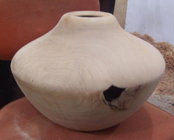- Joined
- Nov 24, 2019
- Messages
- 42
- Likes
- 745
- Location
- Dresher, Pennsylvania
- Website
- www.rareearthbowls.com
I am curious about people's experiences with larger hollow forms. I am contemplating a piece of wood in my shed that is about 15" diameter and 20" long (it might end up a little smaller than that by the time it is trued up and shaped). I do not have a steady rest. I generally use the Trent Bosch hollowing system for my hollow forms. Am I biting off more than I ought to chew? What's the largest piece you've hollowed without a steady rest of some sort? Thanks for any advice.

